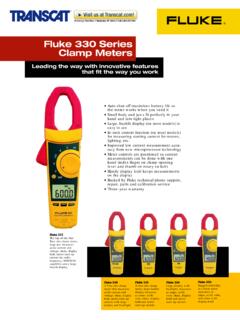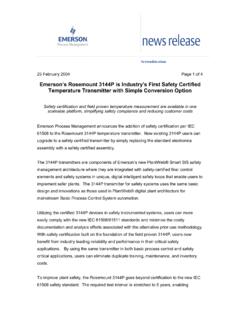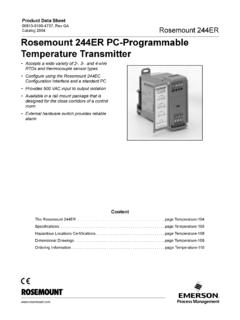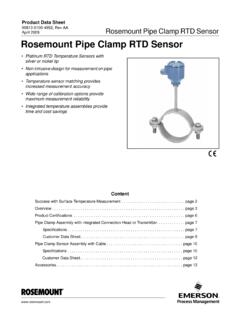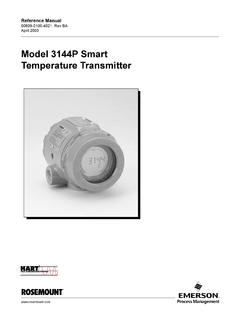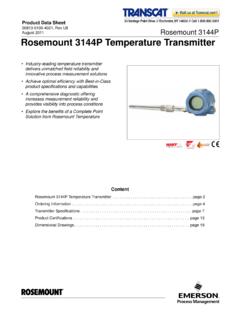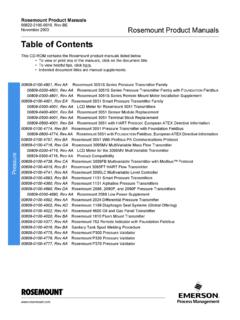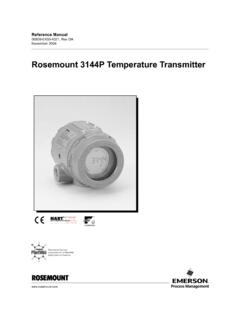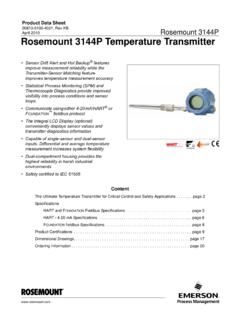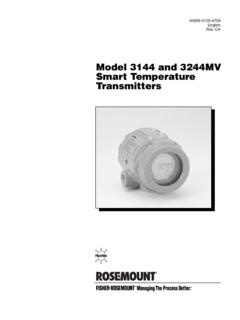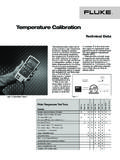Transcription of Rosemount 0085 Pipe Clamp Sensor - Transcat
1 Product Data Sheet00813-0100-4952, Rev BBJanuary 2012 Rosemount pipe Clamp Non-intrusive design for fast and easy temperature measurement in piping applications Platinum RTD Temperature Sensors with silver or nickel tip Non intrusive design for measurement on pipe applications Temperature- Sensor matching provides increased measurement accuracy Wide range of calibration options provide maximum measurement reliability Integrated temperature assemblies provide time and cost savings Integral assembly with 248 or 648 wireless temperature transmitter provides unparalleled mounting flexibility and accuracy for field-mounted pipeline temperature measurementsContentRosemount 0085 pipe Clamp Sensor .. page 2 Overview ..page 3 Product Certifications ..page 6 pipe Clamp Assembly with Integrated Connection Head or Head Mounted transmitter ..page 7 pipe Clamp Sensor Assembly with Cable .. page 11 Accessories ..page 13 Rosemount 0085 pipe Clamp SensorProduct Data Sheet00813-0100-4952, Rev BBJanuary 2012 Rosemount pipe Clamp Sensor2 Rosemount 0085 pipe Clamp SensorProven pipe Clamp sensors deliver excellent performance and reliability Superior accuracy and stability Decreased response time with silver and nickel tip Calibrations according DKD standardsEasy implementation and installation in existing application Available in a wide variety of pipe sizes and material Installation with only two screws no welding needed Optimized surface contact by spring loaded Sensor design Minimized risk of Sensor failure and unplanned shutdowns Avoids flow, pressure, chemical, abrasion, vibration and bending stresses.
2 And thus measuring errors Maintenance of Sensor without shutdown of processAchieve optimal efficiency with Rosemount wireless transmitter offering Measure your temperature where you need it - at well heads, on offshore platforms, or even pipelinesExplore the benefits of a Complete Point Solution from Rosemount Temperature Measurement An Assemble Sensor option enables Emerson to provide a complete point temperature solution, delivering an installation-ready transmitter and Sensor assembly Emerson has a complete portfolio of Single Point, High Density, and Wireless Temperature Measurement solutions, allowing you to effectively measure and control your processes with the reliability you trust from Rosemount productsExperience global consistency and local support from numerous worldwide Rosemount Temperature sites Experienced Instrumentation Consultants help select the right product for any temperature application and advise on best installation practices.
3 An extensive global network of Emerson service and support personnel can be on-site when and where they are Data Sheet00813-0100-4952, Rev BBJanuary 20123 Rosemount pipe Clamp SensorOverviewRosemount pipe Clamp OverviewEmerson offers a wide range of RTDs and thermocouples alone, or as integrated temperature assemblies including Rosemount Temperature Transmitters and connection pipe Clamp Platinum RTD Sensors are highly linear and have a stable resistance versus temperature relationship. They are used primarily in industrial environments where high accuracy, durability, and long-term stability are required, and are designed to meet the most critical parameters of international standards: IEC 751 1983/DIN EN 60751 incorporating Amendments 1 and 2.(1) RTD sensors offer enhanced performance and optimal pipe Clamp temperature measurement accuracy when coupled with temperature transmitters using Callendar-van Dusen constants.
4 Emerson offers two designs of the pipe Clamp RTD Sensor . The grated head design is suitable for all above ground applications such as refineries, chemical plants, and oil and gas fields. The pipe Clamp RTD Design with Cable meets the requirements for underground installation and allows for long wiring distances and for pipe movement in extreme pipe Clamp Sensors are available with flying lead or terminal block lead wire terminations in a variety of lengths and ranges and are available in single and dual element types. Additionally, spring loaded pipe clamps are offered for most industrial applications in a wide range of materials, styles, and lengths. Standard materials include SST 304 and Duplex, while other materials for corrosive environments are also available. Emerson also offers pipe Clamp Sensors as cable assemblies. Consult with your Emerson representative for more the Extension Length for a pipe Clamp SensorA direct mounting configuration allows heat from the process, aside from ambient temperature variations, to transfer from the pipe Clamp to the transmitter housing.
5 If the expected process surface temperature is near or above the transmitter specification limits, consider using additional extension length or a remote mounting configuration to isolate the transmitter . Figure 1 provides an example of the relationship between transmitter housing temperature rise and distance from the 1. transmitter Housing Temperature Rise vs. Uninsulated Distance from the ProcessExampleThe rated ambient temperature specification for the transmitter is 85 C. If the maximum ambient temperature is 40 C and the temperature to be measured is 540 C, the maximum allowable housing temperature rise is the rated temperature specification limit minus the existing ambient temperature (85 40), or 45 shown in Figure 1, an uninsulated distance from the process of 90 mm will result in a housing temperature rise of 22 C. Therefore, 100 mm would be the minimum recommended distance from the process providing a safety factor of about 25 C.
6 A longer length, such as 150 mm, is desired to reduce errors caused by transmitter temperature effect, although in that case the transmitter may require extra support.(1) 100 at 0 C, = x C/ 6050403020100135160185210 235 260285 Housing Rise Above Ambient ( C)Uninsulated Distance from the Process (mm)815 CProcessTemperature540 CProcessTemperature250 CTemperatureProcessProduct Data Sheet00813-0100-4952, Rev BBJanuary 2012 Rosemount pipe Clamp Sensor4 transmitter - Sensor MATCHINGBy using a temperature Sensor matched to a temperature transmitter , significant measurement accuracy improvement can be attained. This involves identifying the relationship between resistance and temperature for a specific RTD Sensor . This relationship is approximated by the Callendar-van Dusen equation:Rt = Ro + Ro [t ( 1)( ) ( 1)( )3], where:The exact values for the Callendar-van Dusen constants (Ro, , , are specific to each RTD Sensor and are established by testing each individual Sensor at various temperatures .)
7 Rosemount pipe Clamp RTD Sensors can be ordered Sensor Calibrated to a Fixed Temperature Range, as shown in Table 2 on page 5, where the values of all four Sensor specific constants are supplied for each Sensor . To utilize the unique, built-in Sensor -matching capability of the Rosemount 644 and 3144p transmitters, the Callendar-van Dusen constants can be programmed into the transmitter at the factory, or in the field using a Field transmitter uses the Callendar-van Dusen constants to generate a Sensor curve describing the relationship between resistance and temperature for this particular Sensor and transmitter assembly. There is a 3- or 4-fold improvement in temperature measurement accuracy for the total system by using the Sensor s actual resistance vs. temperature curve. The Sensor is calibrated specific to a particular temperature range and, as with calibration schedules, the accuracies associated with this option represent worst case conditions, when the Sensor is used over the entire temperature 751 InterpretationThe Callendar-van Dusen equation is one method used to describe the resistance versus temperature (R ) relationship for platinum RTDs.
8 International Standard IEC 751 interprets the R vs. T relationship using an approach similar to the Callendar-van Dusen methodology. The IEC 751 R relationship standard uses the following equation:Rt = Ro[1 + At + Bt2 + C (t-100)t3]As in the Callendar-van Dusen method, Ro, A, B, C are specific for each RTD and are established by testing each Sensor at various temperatures . The actual values for A, B, and C differ in magnitude from the Callendar-van Dusen constants (Ro, , , ), while Ro is the same for both equations. Either methodology produces the same result in any transmitter - Sensor Matching scenario, since one equation is a simple mathematical interpretation of the = Resistance (ohms) at Temperature t ( C)Ro = Sensor -Specific Constant (Resistance at t = 0 C) = Sensor -Specific Constant = Sensor -Specific Constant = Sensor -Specific Constant (0 at t > 0 C) TABLE 1. pipe Clamp InterchangeabilityPipe Clamp RTD IEC-751 Class BTemperature C ( F) -100 C (-148 F) C ( F) 0 C (32 F) C ( F) 100 C (-212 F) C ( F) 300 C (572 F) C ( F) 400 C (752 F) pipe Clamp RTD with IEC-751 Class A OptionTemperature C ( F) -100 C (-148 F) C ( F) -0 C (32 F) C ( F) 100 C (212 F) C ( F) 300 C (572 F) C ( F) 400 C (752 F)Typical transmitter - Sensor Matching Accuracy ImprovementsTransmitter: Rosemount 3144p (built-in Sensor matching capabilities), span of 0 to 200 C, accuracy = C) Sensor : pipe Clamp RTDC allendar-van Dusen Option: -50 to 150 CProcess Temperature: 150 CProduct Data Sheet00813-0100-4952, Rev BBJanuary 20125 Rosemount pipe Clamp SensorCALIBRATIONS ensor calibration may be needed for input to quality systems, or for control system enhancement.
9 It is used mainly to improve the overall temperature measurement performance by matching the Sensor to a temperature OptionsSensor Calibrated to a Customer-Specified Temperature Range option calibrates the Sensor to a customer-specified temperature range. The Callendar-van Dusen, and A, B, and C-constants are supplied with a calibration ordering an RTD with this option, the temperature range for the Sensor calibration needs to be Calibrated to a Customer-Specified Single Measurement Point option refers to the above option when calibrated on a single temperature Calibrated to a Fixed Temperature Range option is where the RTD Sensor is calibrated within standard temperature ranges (Table 2 on page 5). To achieve optimum performance, select the option that corresponds to the operating temperature range for your application. TABLE 2. Temperature Range OptionsSENSOR TIP MATERIAL CONFIGURATIONThe mount pipe Clamp Sensor plate tip is constructed of silver or nickel for better thermal conductivity and to reduce the thermal response time of stainless steel designs.
10 Silver tip plate temperature range is -50 to 300 C (-58 to 572 F), and the nickel tip plate temperature range is -110 to 300 C (-166 to 572 F).System Uncertainty Comparison at 150 C: pipe Clamp SensorRosemount 3144p : CStandard pipe Clamp RTD: CTo t a l S y s t e m(1):(1) Calculated using RSS statistical method: CPipe Clamp Sensor Calibrated to a Fixed Temperature RangeRosemount 3144p : CCalibrated Sensor pipe Clamp RTD: CTo t a l S y s t e m(1): CStandardWith Sensor MatchingTransmitterAccuracy 2 SensorAccuracy 2+=System accuracy = transmitter accuracy Sensor accuracy Temperature RangeCalibration Points ( C)0 to 100 C (32 to 212 F)0, 50, 100-50 to 100 C (-58 to 212 F)-50, 0, 50, 100-50 to 150 C (-58 to 302 F)-50, 0, 100, 150 Product Data Sheet00813-0100-4952, Rev BBJanuary 2012 Rosemount pipe Clamp Sensor6 Product CertificationsHAZARDOUS LOCATIONS CERTIFICATIONF lameproof ApprovalMarking II 2 GCertification Number.


